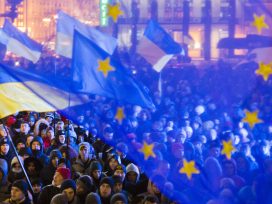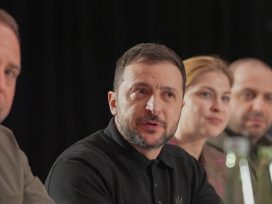Decentralizing the Cold War
When Boris Yeltsin told George Bush in 1991 that the USSR couldn’t exist without Ukraine, he wasn’t referring to the economy: culturally, Russia would have been isolated. Today, the same thesis about Slavic identity is being debated with rockets. Serhii Plokhy on Ukraine’s special role in Soviet and post-Soviet history.
Katherine Younger:
Since the start of Russia’s full-scale war against Ukraine in February, we have all been forced to revisit some of the conventional wisdom about the recent past. Take our understanding of the Cold War: both what it was really about and, perhaps especially, how it ended.
In your lecture at the IWM in March, you drew an important distinction between what we understand by the ‘end of history’ and the end of the Cold War. Could you elaborate?
Serhii Plokhy: The precise chronology of the Cold War is difficult to pinpoint. It doesn’t have a clearly defined beginning, though it is generally understood to be in the late 1940s. There is also disagreement about when exactly the Cold War ended. Generally, it’s thought to have ended with the fall of the Berlin Wall in 1989. But then someone like James Baker, the US Secretary of State under George H.W. Bush, would point to the Soviet decision not to oppose the American invasion of Iraq in 1990. Then there was the fall of the Soviet Union in 1991. There is, in fact, no single agreement on when exactly the Cold War ended. It ended in different places at different times. And in the post-Soviet space, I would argue that it never actually came to an end.
The two Cold War superpowers agreed on a number of issues at that time. One of these was that, as far as nuclear weapons were concerned, the world should remain bipolar, even though the Cold War had, strictly speaking, come to an end. So this aspect of the Cold War was preserved by the two superpowers, and it is still with us today. The repercussions of this decision can be seen in events in Ukraine. As a result of this agreement, other post-Soviet countries that inherited nuclear arms had to be denuclearized.
This created a security vacuum that has never been resolved, either via the Cold War model of NATO expansion or by thinking in terms of the end of history and creating a liberal structure that would embrace everybody. No single model was applied. So, in a sense, the Cold War refuses to end, and the resulting difficulties really do leave their mark.
Another issue dating from this period that has contributed to the current Russo-Ukrainian war is that the US stuck to the idea that the sovereignty of the post-Soviet space was for real. This is Zbigniew Brzezinski’s argument, formulated in Foreign Affairs in 1994, about the crucial importance of political pluralism in the post-Soviet space. And clearly, the Russian leadership looked at the Commonwealth of Independent States as a means to maintain its control, including military control, on the post-Soviet space. The concentration of all the nuclear weapons in the hands of Russia was perceived, at the time, as part of that vision and paradigm. But then there was a disconnect: the US agreed that the nukes should be removed but never agreed that other countries should have limited sovereignty.
This is quite striking, given that there was agreement on many things, including Afghanistan, the Middle East and South Africa, where the Cold War led to a common position between the two superpowers and helped to deal with the issues that were at hand there. But when it came to the post-Soviet space, there was agreement only on the issue of the nukes, and even that created additional problems in the way it was resolved. And there was disagreement on the fate of the post-Soviet republics, which, of course, turned the post-Soviet space into an additional area of insecurity.
From the western borders of the Soviet Union to the so-called soft underbelly of the Caucasus and Central Asia, there was a lot of tension. But in the Baltic states, which were accepted as members of NATO at that time, there was no power or security vacuum. This is not to suggest that NATO was the solution, but simply to state the obvious: that this is what happens when a part of the post-Soviet space isn’t left on its own to deal with this rise of Russia.
Katherine Younger: So when you refer to the removal of the nukes and to the security vacuum, Ukraine is at the centre of the story, in a number of ways. One of the themes that you’ve developed in several of your books is a re-centring of Ukraine in this telling of the story of the Cold War. How does the story change when we start from Ukraine?
Serhii Plokhy: I first noticed that the focus on Ukraine is very beneficial for our rethinking of Cold War history when looking at the collapse of the Soviet Union. This is, of course, a major part of Soviet history, but it’s also a major part of the end of the Cold War. Depending on how you look at it, either the Cold War was a contributing factor to the fall of the Soviet Union or the fall of the Soviet Union was a concluding chapter of it. But without Ukraine, you can’t really understand it. The Moscow-centric approach, with the focus on Mikhail Gorbachev and Boris Yeltsin, has its limits. It’s very interesting in the sense that it shows the tensions and the split eventually between Russia and its former empire, no question about that. But the Soviet Union fell in the end over the issue of Ukraine.
Ukraine happened to be the only country in the post-Soviet space that had a referendum on independence. The Ukrainian vote for independence in effect decided the future of the majority of Soviet citizens, from Russia to Kazakhstan, to Central Asia. Both Gorbachev and Yeltsin refused to imagine the Soviet Union without Ukraine. And the Soviet Union was dissolved a week after the Ukraine referendum. Of course, this is just the state of things on the surface. But they’re also hidden in the open: they are there, but it is difficult to see them. Once we do see them, the question is, what does this mean? Why is Ukraine so important? And there are multiple explanations.
One of the most obvious answers is that it was the second-largest Soviet economy. The key issue that was discussed at the time of the Soviet collapse was the economic viability of the empire. This is one of the issues that contributed to almost every empire in the second half of the twentieth century falling apart: the economic model didn’t work anymore. Russia was not prepared to continue with this ‘burden of the empire’ – the economic burden of the empire in conditions of crisis – without the second-largest economy. So, it was about the economy.
But there are also other elements. When Yeltsin explained to George Bush in 1991 why the Soviet Union couldn’t continue without Ukraine, the argument was not economic, but cultural. Ukraine was Slavic, it was Orthodox, and without Ukraine, Russia would essentially be alone in the Soviet Union with the Muslim and Central Asian republics. That’s what he was saying again, and again. Once more, there’s this cultural component at play.
Of course, this is very important, especially when we look at that history from today’s standpoint, at the issues of Slavic identity, whether the Russians and Ukrainians are one and the same people, and so on. These became not just obscure issues for academics but issues to be debated with javelins and a new generation of weapons in Ukraine today.
So, to summarize, there is the economy, there is the ethnic component, and there is the cultural component. And one thing that also came to my attention, very clearly, was the importance of the Ukrainian political elite, the communist elite in Soviet history after the Second World War. Already in the 1930s in the Soviet Union a system of government was emerging that continues until today in Russia – a system in which regional elites would capture the control of the state. This began with people from the Caucasus, led by Stalin: Sergo Ordzhonikidze, Anastas Mikoyan and Lavrentii Beria. Somehow the people from the Caucasus turned out to be more talented than others in the 1920s and 1930s.
And then, by the 1960s and 1970s, those elites were Ukrainian, and their dominance lasted into the 1980s. Nikita Khrushchev’s ouster as First Secretary in 1964 didn’t lead to the changing of the guard in Moscow. And that is an interesting story, a very imperial story, of the rise of a particular Ukrainian elite and relationship with the empire. This rise of the Ukrainian elite is framed by the chronology of the Cold War. So, it is not a phenomenon of the interwar period so much. It is the phenomenon of the Cold War.
In my research on the history of the Cuban Missile Crisis, one of the things that come to the fore is that every single ballistic missile that was delivered to Cuba was produced in Ukraine. And the people who oversaw their missile forces happened to also be very close personally to Khrushchev and to his Ukrainian mafia.
So, again, this provides you with a different perspective on how the Soviet elites operated, how their links and connections worked. This is an important part of the Cold War story in its own way.
Finally, there is the story of the dissident movement: up until the mid-1970s, Ukrainians – and this was documented by people like Alexander Solzhenitsyn – were overwhelmingly the largest ethnic group in the Gulag. This is the story of Ukrainian resistance to the Soviet regime in western Ukraine, which is the opening part of the Cold War. The Cold War starts after the end of the Second World War II in 1945 with the victory of the Red Army. But in 1948, 1949, 1950, whichever year you choose to start talking about the Cold War – you can go all the way to 1951 or 1952 – there is still a war going on within the borders of the Soviet Union. And it becomes in a sense a continuation of the Second World War: the Soviets are trying to establish themselves fully in the territories that they claimed as the result of the Molotov-Ribbentrop Pact.
But it’s also the opening salvo of the Cold War. The first group of people the CIA or MI6 tries to parachute into the Soviet Union are not Russians, they’re not Estonians, they’re not Lithuanians, they’re Ukrainians. And they are going there believing that there is deep resistance going on, that there is a basis for that. This is again an extremely important part of the Cold War history, this resistance to the Soviet regime, first in armed resistance, and then the continuation within the Gulag and dissident movement.
Ukraine also provides a different understanding of what the dissident movement was about. The main focus at the time would be Moscow, and there the dissidents were being very clearly defined again, quite simplistically, according to two camps: the Russian nationalists were represented by Solzhenitsyn and the liberals by Andrei Sakharov.
When you start looking for that division in Ukraine, you see that it doesn’t exist. The Helsinki Act and human rights ideology and rhetoric produced the multi-ethnic amalgam of the Ukrainian dissident movement, which has a very interesting dimension to it: liberal nationalism. Liberal nationalists by definition don’t exist in Russia until 1991, partly because there were no roots for liberal nationalism in the dissident movement of the 1970s and 1980s.
But there were such roots in Ukraine. These organizations existed and, more importantly, there were ideologies that brought together individuals such as prominent dissidents Semyon Gluzman, Josef Zissels, Viacheslav Chornovil and Levko Lukianenko. They were very different people, but they created a common space where they could work together and co-operate, and they learned how to do that in the camps. They passed this know-how to the generation of the 1990s. Moreover, they themselves were very active participants in this process. This is one of the very interesting outcomes and results of the Cold War – or perhaps an unintentional consequence, since no one was looking at the rest of the Helsinki Act as something that would change the Soviet Union. But it also changed the post-Soviet space. It’s difficult to make this case and to understand that, without some form of decentralized study of the Cold War. This means not just moving beyond thinking in terms of the Soviet Union and the US, but even within this Soviet Union, looking at the agency of the actors who were part of the Cold War propaganda wars but not taken seriously by policymakers.
Katherine Younger: Solzhenitsyn is in fact the motivation behind my next question to you. There’s a tendency now to debate whether Putin is motivated by memory of the imperial project or by memory of the Soviet Union. But I think one of your contributions is to draw attention to the way in which this kind of traditional imperial period shares characteristics and actors with the Soviet period. And then, the post-Soviet period also shares some of these actors and ideas.
One of the interesting points that you make is how we in the West think of Solzhenitsyn in terms of his The Gulag Archipelago published in 1973. We think of Solzhenitsyn as a human rights actor. But that’s not the role that he plays where Ukraine is concerned. Your argument is that Solzhenitsyn is, as it were, sitting behind Putin’s thinking today. How do you see the continuing influence of Solzhenitsyn?
Serhii Plokhy: Well, it’s interesting to look at the differences between the time when Solzhenitsyn was exiled and the moment he decides to go back to Russia. The period of late Gorbachev and early Yeltsin is dominated by either Sakharov, or people associated with Sakharov. In other words, it is the pro-Western, liberal contingent that drives that agenda. Solzhenitsyn, however, returns when liberalism in Russia is in deep crisis. And he stages this triumphal return to Russia, travelling in a train from Vladivostok to Moscow.
He clearly somehow managed to live without his beloved Russia through the turn of the 1990s. This was a time when he could have been able to return and embrace the Russia that he loved. But the problem was that the Russia that he loved wasn’t there. It was liberal Russia. It wasn’t nationalist Russia. It wasn’t until 1992 or 1993 that he returned. That was the time when liberalism was already in deep crisis. As a talented writer, he knew that, he understood that, or he must have felt that.
And then, he becomes a symbol of a particular way of thinking about Russia. His essay, ‘Rebuilding Russia’, published in 1990 by leading newspapers and disseminated widely, was about how we should restructure Russia. Was this model based on the imperial notion of the Russian nation? According to Ernest Gellner’s basic principle, nationalism wants ethnic borders to coincide with state borders. So, what is the vision of the state that Solzhenitsyn proposes? How does he propose that we should structure Russia? Russia as a state should include Russia, Ukraine, Belarus and Northern Kazakhstan. He uses terms such as Russians, Ukrainians and Belarusians, but when it comes to the Gellner test, he passes it only as the promoter of this imperial vision with a big Russian nation. And that becomes the foundation of Putin’s idea, that Russians and Ukrainians are one and the same people, a claim that he first states and then writes an entire article about, and subsequently uses as justification for the war in Ukraine.
This was certainly the imperial ideal in 1917. But in terms of who brings this idea to the new Russia, it’s Solzhenitsyn. And, indeed, Putin personally makes a point of visiting him before his death. In 2009 he put flowers on the gravestone of General Anton Denikin, the leader of the White Guard, and quotes Denikin: ‘Russia and Ukraine, no one has the right to interfere in our relations. Russia will decide.’ And he puts flowers also on the grave of philosopher Ivan Ilyin and on the grave of Solzhenitsyn. So, that’s the package. There was also Ivan Shmelev, a writer who wrote about the Russian imperial period. That’s the pantheon that has been created by Putin. He funds the restructuring of the gravestone of Denikin and his wife. He tells his spiritual advisor, Archimandrite Tikhon, that he was really impressed and surprised when he was communicating with Solzhenitsyn, what a really great gosudarstvennik (statist) he was.
When they opened an enormous monument to Prince Vladimir in Moscow, of course Solzhenitsyn’s wife was present. So, there is this personal connection, respect on the personal level, stated publicly more than once. And there is continuity of thought. In Solzhenitsyn’s 1998 work Россия в обвале (Russia in Collapse), he specifically raises the question of the territories within Ukraine which, in his mind, are Russian, should be Russian, including Melitopol, including the Northern Azov Sea.
One need only look at the map today and what is happening there. Again, I am careful not to push this too far. But on the other hand, there are these coincidences that really ask for closer analysis and some form of explanation. However, even without taking these into consideration, one can see clearly enough the influence of Solzhenitsyn. Because Solzhenitsyn is really a translator of the Russian imperial thinking for post-Soviet Russia.
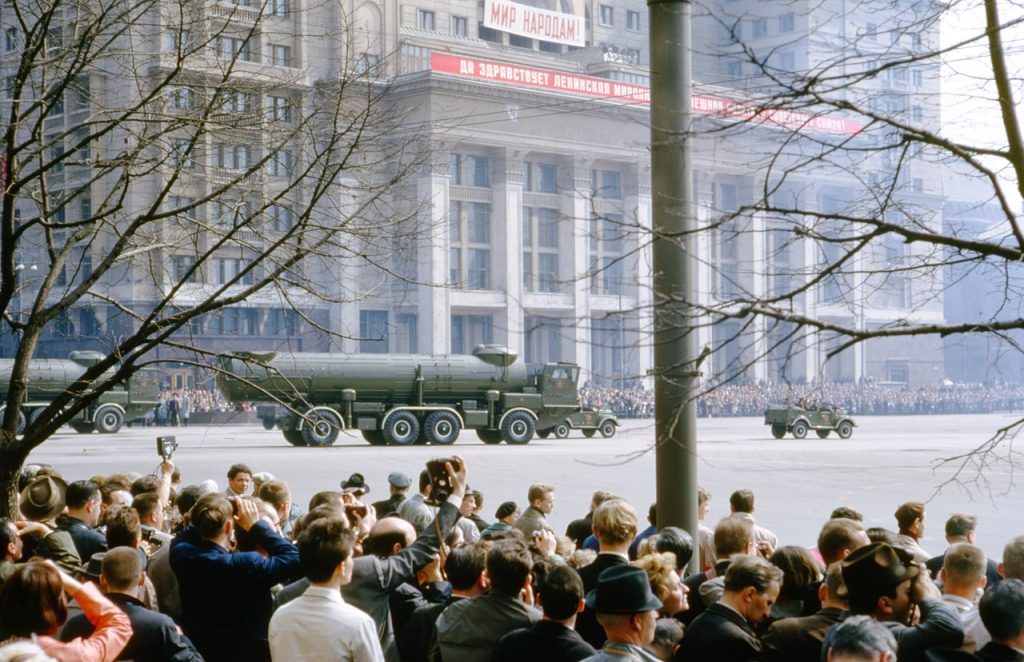
Moscow, 1 May parade 1964. The image shows a P-5 ‘Pyatyorka’ cruise missile. Author Thomas T. Hammond; Source: Wikimedia Commons
Katherine Younger: Another major interest of yours with regards to the second half of the twentieth century is nuclear power. The Cold War is also, in a sense, the nuclear age. Your work has addressed this from two angles: on the one hand, the threat of nuclear war; on the other, nuclear power, particularly the possibility of nuclear accidents. Both are extremely important for any attempt to understand that period. It’s inevitable that the Cuban Missile Crisis comes to mind today now that Putin has very clearly laid the nuclear card on the table and that this has been used as justification for not responding strongly enough to the war. What is your view?
Serhii Plokhy: The parallels between the current situation in and around Ukraine and the Cuban Missile Crisis were drawn even before the start of the war. And the argument then was to say, well, look at how the US reacted to the Soviet Union encroaching on their territory in Cuba. Surely now you should be more understanding to Putin’s reaction to alleged encroachment in Ukraine. That argument was there. And it was presented on a number of levels. My response then was that the Cuban Missile Crisis was about missiles. And once we locate NATO missiles on the territory of Ukraine, I would consider that parallel to be really very productive.
There was a real threat of the war going nuclear and the threat is still there, associated with what are, in essence, acts of terrorism, with the reckless takeover of nuclear sites from Chernobyl to the Zaporizhzhia nuclear power plant where a land battle was waged. In Chernobyl, they were digging the trenches in the Red Forest, the most contaminated area on the planet. And now the authorities cannot account for over 100 samples of the highly radioactive materials that were used to calibrate the equipment of the nuclear power plant. It was just stolen and shipped somewhere to Russia.
I started with the term ‘reckless’: waging war on the territory of the nuclear sites, digging trenches in the most contaminated areas, stealing the quintessential elements of radioactive contamination, and removing them. The electricity was cut to the nuclear power plant in Chernobyl for a number of days, endangering the work of the pumps that were cooling the elements of fuel that were still there since 2000, when the last reactor was shut down. So, that was and is and continues to be the real danger of the nuclear component in this war, damaging not just Ukraine but also parts of Russia and parts of Europe.
The focus has been, however, not on this but on Putin threatening, and then Lavrov later talking about raising the level of readiness of the nuclear forces. It took a while for that quite panicked reaction to subside. And we here are back in the situation of the Cold War where global peace was contained, partially also because of the fear that existed with regards to nuclear weapons. This fear that we experience today is not new. But the point is that the fear is mutual. And the Russian Federation is not the only country that has nuclear weapons that it can use.
What happened after this initial panic is the realization that, again, you can’t really threaten and hold the entire world hostage if you don’t have a monopoly on nuclear weapons. And that was one of the lessons from the Cuban Missile Crisis. Because in the end, if there would have been a war between the US and the Soviet Union, there would have been nuclear weapons used – if Khrushchev and Kennedy hadn’t faced the fact that escalation to a nuclear war would have been a disaster.
I emphasize in my 2001 book Nuclear Folly, and would like to emphasize now, not only the presence of the nuclear weapons but also the realization of what that means. What we are experiencing now is in fact a real change in our thinking about nuclear weapons. There is a return to the Cold War understanding that not only can you threaten with nuclear weapons, but also use them as a counter threat, so that they can actually bring some benefits as well.
What is not yet understood is the new threat which comes with nuclear power stations today. This was not part of the Cold War experience. There are more than 400 nuclear reactors in the world today. The war in Ukraine is frequently compared to the Second World War, in terms of the number of tanks and artillery, and the number of troops on the ground and so forth. But there are new elements to this war and that’s where our thinking and public awareness should be focused. This is a new danger, especially given that those who think they are fighting the Second World War in this new nuclear age – in other words, the Russian military – are probably operating from a level of understanding of the threat this entails that bears more resemblance to prehistoric feeling.
A shorter version of this interview was published in German under the title Die Ukraine, der Kalte Krieg und der Krieg in the IWMpost.
Published 19 September 2022
Original in English
First published by Eurozine
Contributed by IWM (The Institute for Human Sciences) © Serhii Plokhy / Katherine Younger / IWM (The Institute for Human Sciences) / Eurozine
PDF/PRINTIn collaboration with
In focal points
Newsletter
Subscribe to know what’s worth thinking about.
Related Articles
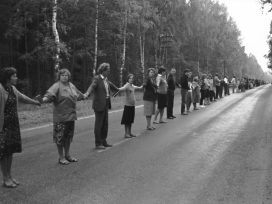
The fall of the Berlin Wall, and not the human chain across the Baltics, is emblematic of 1989. But what if this show of unity had become iconic of communism’s disintegration? Could acknowledging Eastern Europe’s liberation positively reframe what Russia otherwise perceives as loss since the Soviet Union’s demise?
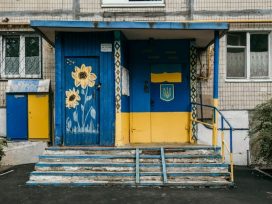
Ukraine faces its greatest diplomatic challenge yet, as the Trump administration succumbs to disinformation and blames them for the Russian aggression. How can they navigate the storm?

